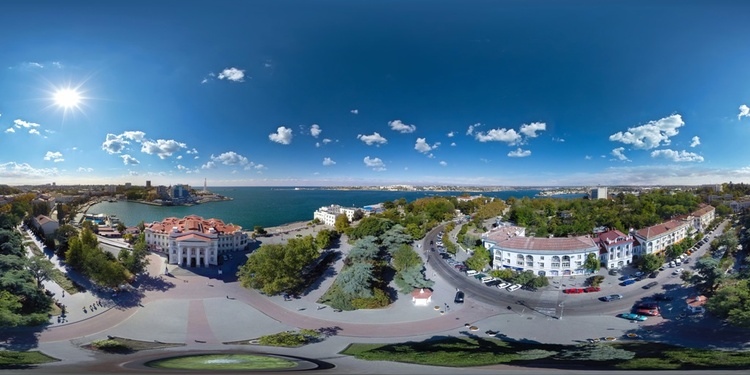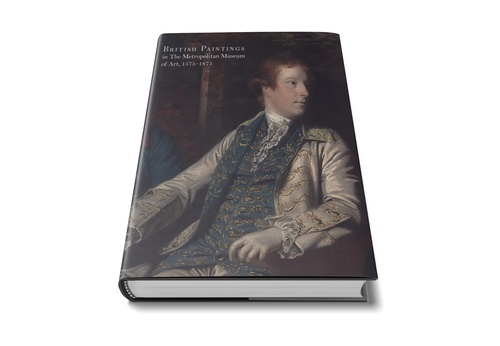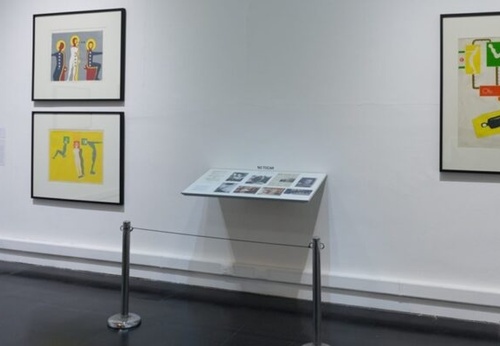
360° photography machine
The 360° camera is a camera capable of taking a complete panoramic photograph (covering the entire area) on a single negative from a certain point.
History
The camera was invented by Sebastião Carvalho Leme,a Brazilian photographer when he lived in Marília, São Paulo. In 1957, a businessman requested a photograph of his buildings at a confluence of three corners, and his interest was to show all the buildings in a single photo — which would necessarily have to be done in 360 degrees.
Using a Rolleiflex camera with a panoramic head, ten negatives were taken which, when enlarged and assembled, resulted in the desired photo.
The challenge arose: Why not take a photograph covering 360 degrees on a single negative?
The invention
Lemos put that challenge on his mind's "agenda" and began to consider a solution to the case. The embryo of an idea emerged. It was, therefore, patented under number 99 271 at the then National Department of Industrial Property (now extinct and succeeded by the National Institute of Industrial Property) on November 26, 1957. A lens was installed in a can of tomato paste, a special internal device (which is the principle of the invention) and a piece of film fixed inside the can. With his hand he turned the objective, thus carrying out the first test to feel the possibilities. The test was carried out in front of the Senai building using the 360° photography system. Once the film was developed, the possibility of taking 360° photos was precariously proven. Once the first prototype was made, already mechanized, confirmation came. Three prototypes were made, taking around a year to perfect.

In the meantime, certain that he had found the solution for taking 360° photos, Leme arranged the patent process that was processed for a few years at the National Department of Industrial Property, during which time the viability of the system and the existence of similar systems were researched, granting The patent was issued on April 23, 1962 under number 61,472. Approximately 20 years after the granting of the patent, a similar system appeared in the United States, without, however, the internal device mentioned above.

The machine remained inactive for fifteen years. At the end of 1997 it was reactivated and improved, and began to be used again.



- July 12, 2025
Art as a tool for “a healthy and creative old age”

- July 12, 2025
The Sleep of the Unjust




- July 12, 2025
Gallery Of Painting By Sergio Guillermo Diaz - Argentina

- July 12, 2025
Mexico City

- July 10, 2025
The Evolution of Graphic Design from Ty…

- July 10, 2025
How Digital Artists Collaborate with Ar…

- July 09, 2025
The Value of Art in Education

- July 09, 2025
Art as a Reflection of Society

- July 08, 2025
The history of Bolivian art

- July 08, 2025
Protecting Art in the Age of Artificial…

- July 04, 2025
Graphic Design and Creating Iconic Bran…

- July 04, 2025
Photography as a Tool for Telling Histo…

- July 03, 2025
Painting and abstract art: differences …

- July 02, 2025
The Best Software for Digital Art and G…

- July 01, 2025
How Digital Artists Collaborate with Ar…

- July 01, 2025
Reflections of Digital Art in Different…

- June 30, 2025
Crítica de Obras Artísticas Criadas por…

- June 30, 2025
What are Plastic Arts?

- June 30, 2025
Images Against Silence: Artists Who Cha…

- June 29, 2025
History of Art Photography in the 20th …

- June 28, 2025
The 11 types of art and their meanings

- June 28, 2025
Contemporary Art is postmodern art

- June 26, 2025
Graphic Design, Art, and Technology: Wh…

- June 25, 2025
Graphic Design and Modern Content Creat…

- August 29, 2023
The history of Bolivian art

- February 19, 2024
Analysis and meaning of Van Gogh's Star…

- January 28, 2024
Culture and Art in Argentina

- September 25, 2023
What is the importance of art in human …

- September 23, 2023
What is paint?

- August 10, 2023
14 questions and answers about the art …

- August 30, 2023
First artistic manifestations

- August 23, 2023
The 11 types of art and their meanings

- January 12, 2024
10 most beautiful statues and sculpture…

- September 23, 2023
Painting characteristics

- September 23, 2023
History of painting

- March 26, 2024
The importance of technology in art1

- August 16, 2023
The 15 greatest painters in art history

- April 06, 2024
History of visual arts in Ecuador

- January 31, 2024
Examples of Street Art – Urban Art

- April 07, 2024
Graffiti in Latin American culture

- March 26, 2024
Cultural identity and its impact on art…

- January 20, 2024
What is the relationship between art an…

- October 21, 2023
Contemporary art after the Second World…

- August 25, 2024
A Comprehensive Analysis of the Cartoon…

- February 19, 2024
Analysis and meaning of Van Gogh's Star…

- August 13, 2023
9 Latino painters and their great contr…

- August 10, 2023
14 questions and answers about the art …

- August 29, 2023
The history of Bolivian art

- January 28, 2024
Culture and Art in Argentina

- August 23, 2023
The 11 types of art and their meanings

- November 06, 2023
5 Latin American artists and their works

- August 27, 2023
15 main works of Van Gogh

- September 23, 2023
Painting characteristics

- September 23, 2023
What is paint?

- September 25, 2023
What is the importance of art in human …

- December 18, 2023
10 iconic works by Oscar Niemeyer, geni…

- August 30, 2023
First artistic manifestations

- January 20, 2024
What is the relationship between art an…

- March 26, 2024
Cultural identity and its impact on art…

- January 12, 2024
10 most beautiful statues and sculpture…

- October 30, 2023
Characteristics of Contemporary Art

- August 22, 2023
What are Plastic Arts?

- April 16, 2024
The most important painters of Latin Am…

- August 24, 2023


